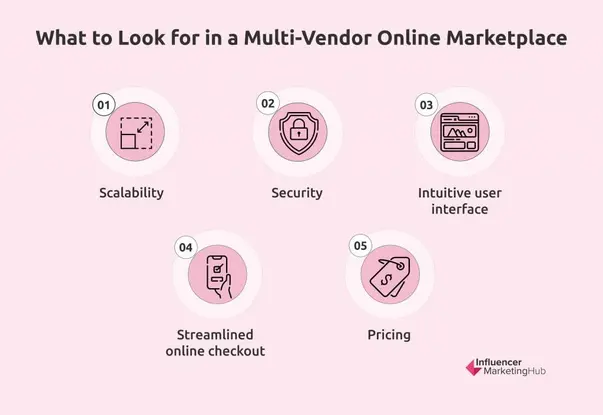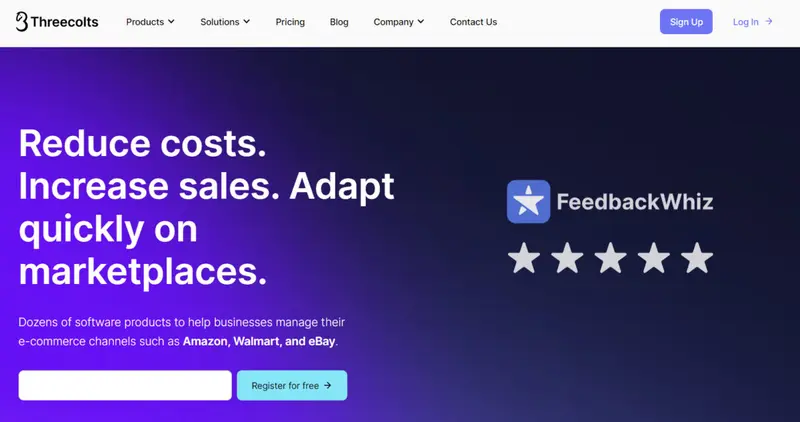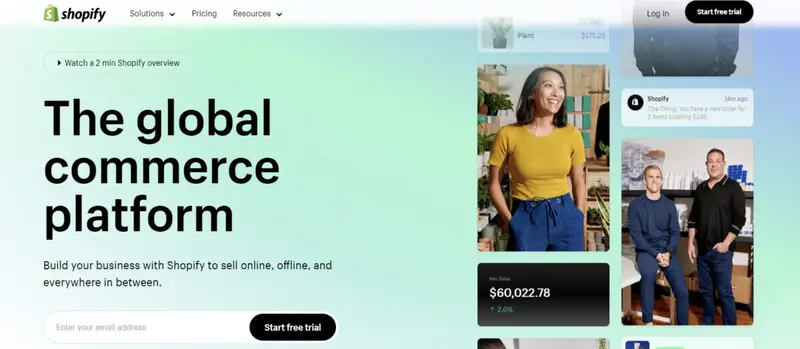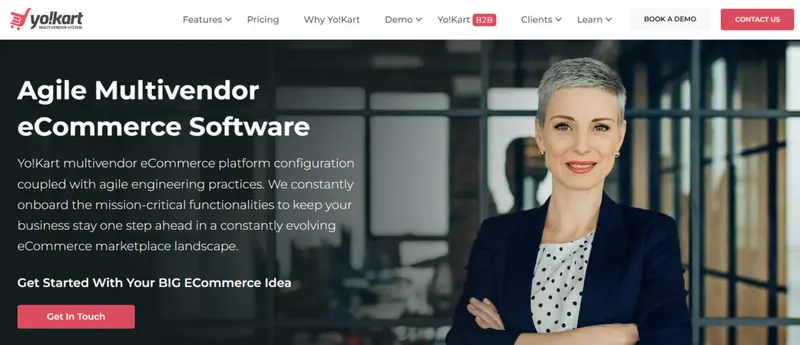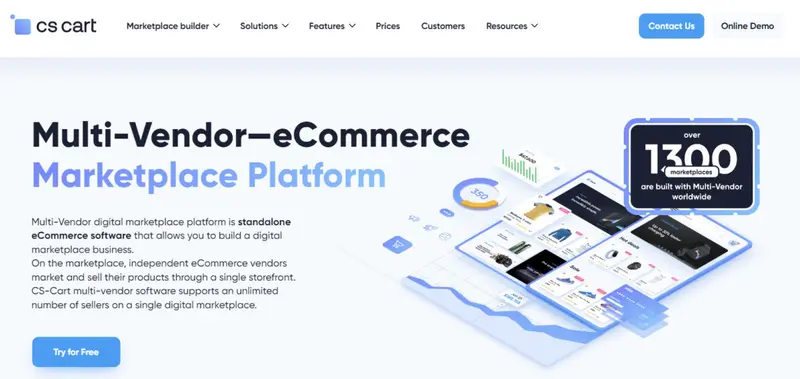By 2027, the e-commerce market is expected to total over $7.9 trillion, reflecting the rapid evolution of shopping trends and consumer behavior in recent years. Online marketplaces have become a dominant force, providing consumers with convenient shopping options and businesses with new opportunities for growth.
But with the vast selection of available marketplaces, promoting your products online can be overwhelming, especially if you don’t know where to begin. Changing platforms after launching your business can be a hefty process, so it’s better to get it right the first time.
Multi-vendor online marketplaces offer a convenient way for consumers to browse and shop for products. At the same time, they allow brands to promote and sell their products without worrying about back-end logistics. Choosing the best multi-vendor e-commerce platforms can help you attract your target market, grow your audience, and increase your revenue.
Defining Multi-Vendor Online Marketplaces
A multi-vendor online marketplace is a software solution that lets brands or sellers list and sell their products or services on the internet. Think shopping malls, but with a wider variety of products, and anyone can set up a shop.
Multi-vendor online marketplaces help merchants reach a larger audience and increase their visibility online. Consumers can browse the offerings and buy from any shop on an e-commerce platform. No matter your industry or business size, you can use an e-commerce platform to sell your products and services.
How Do They Work?
Before anything else, a brand or seller signs up on the online platform and customizes their storefront to stand out from other sellers. Then they list their products or services and respective prices. Some of the features of e-commerce marketplaces also allow sellers to post multiple pictures of their items, write a description for each, and indicate their preferred modes of payment.
When a customer purchases an item from any of the stores, the multi-vendor online platform handles most back-office operations. That includes inventory management, warehouse or storage, customer service, payment processing, and order fulfillment. This arrangement reduces stress among businesses, allowing them to operate their stores more efficiently.
Benefits of Selling on Multi-Vendor Online Marketplaces
Huge audience access
Ecommerce has boosted the number of online shoppers worldwide. In 2024, digital buyers totaled 2.71 billion and are projected to increase to 2.77 billion by 2025. Most audiences use them as a jump-off point when searching for new brands. Putting yours on these platforms can help you connect to both new and old audiences without spending anything on marketing. It’s a good opportunity for small businesses with limited marketing funds.
Then, to help you make the most of your marketing budget, it’s also a good idea to sign up for a platform like Pacvue which can help with many aspects relating to using online marketplaces. In addition to advertising, it can also help with sales and managing retail operations.
You can use it to:
- Conduct keyword research
- Get inventory forecasts
- Access sponsored search ads and other types of ads on numerous retailers’ websites
- Identify market share growth
Brand exposure
Some online shoppers, especially those visiting niche marketplaces, discover their new favorite shops on an online marketplace. That’s because these platforms recommend products to consumers through related searches, helping boost a brand’s visibility without cost. Exposure also helps build consumer trust, which eventually motivates them to purchase from that shop.
Increased revenue
Established multi-vendor online marketplaces gain a lot of traffic that both small and large enterprises use for selling and promoting their products. For example, a lot of notable brands use Shopify to drive traffic to their sites and boost their sales. Listing your brand on an online marketplace will allow you to take part in that revenue growth.
Low costs
Brands spend very little on an online marketplace. For one, you can sign up on most platforms for free. Some marketplaces may charge a monthly subscription fee. But usually, multi-vendor e-commerce platforms earn from brands through a commission or listing fee. Otherwise, they are still generally affordable, which is a good deal for brands that have limited marketing funds.
Global reach
Businesses usually spend a ton on marketing to attract international audiences. E-commerce platforms, on the other hand, have an international infrastructure. This means that you can use these platforms to sell to both local and international markets without spending a dime. Global reach will help you not only improve your international sales but also grow your business experience.
Multi-Vendor Online Marketplace Types
Here are the three primary types of multi-vendor e-commerce platforms.
- Product-based: These platforms sell a wide range of physical goods at competitive prices, such as apparel, furniture, and home supplies. Amazon and eBay are two examples.
- Niche-based: These marketplaces offer a curated list of niche products, like electronics, home décor, and fashion. Some examples are Etsy and Booking.com.
- Service-based: Marketplaces like these allow sellers to offer both product-based and niche-specific services. For example, vendors can offer an array of home repair and pet sitting services. At the same time, they can also offer writing and tutoring services. Similar platforms include Taobao, Alibaba, Teachable, and Fiverr.
What to Look for in a Multi-Vendor Online Marketplace
Scalability
The low costs of multi-vendor e-commerce platforms are attractive, especially if your business is only starting out. But aside from pricing, you should also consider the platform’s potential to help you grow should you decide to expand in the future. The best platform helps keep you on top of the competition through upgrades and in-person features.
Security
It’s important for customers to purchase from trustworthy e-commerce sites, which should make robust security features one of your top priorities. Highly secure platforms will not only create trust between you and your consumers but also protect you from fraud. Look for an online marketplace that secures user-level information, uses two-factor authentication, and offers secure payment gateways.
Intuitive user interface
Navigating an e-commerce platform should be not only simple but also easy to use for both you and your consumers. Audiences are unlikely to push through with a purchase if the interface looks complicated. At the same time, you want to manage your business from an intuitive dashboard. To get a feel of the user interface, schedule a free demo or start a free trial.
Streamlined online checkout
Making sure that your customers can easily and securely complete their purchase helps create customer satisfaction and increase the potential for repeat customers. A lengthy checkout process can be frustrating for customers and result in cart abandonment. Choose a multi-vendor platform that can offer various payment gateways, as well as familiar checkout options like PayPal and Amazon Pay.
Pricing
It can take time to generate returns when you’re just starting out, so it’s important to consider an e-commerce platform’s pricing plans. Some marketplaces have free plans with limited capabilities, but some may already have the features that you need. Other platforms offer a free trial. Focus only on what your business needs now before looking for features that you think you might need in the future.
Top Multi-Vendor Online Marketplace Software
A multi-vendor online marketplace software enables multiple sellers to establish digital storefronts where they can list and sell their products. Here are the top 6 multi-vendor online marketplace software solutions in 2025.
Threecolts stands as a dynamic and robust multi-vendor online marketplace software, designed to empower businesses to excel in the ever-evolving world of e-commerce. This comprehensive solution is equipped with a supply of features carefully crafted to streamline operations, reduce costs, and enhance profitability across a wide spectrum of online marketplaces, including giants like Amazon, Walmart, and eBay. Threecolts demonstrates real-world success stories. Take, for instance, Thrasio, which harnessed Threecolts to achieve a staggering 97% improvement in customer first-response time. This showcases the software’s tangible impact on elevating customer service standards. Similarly, Juan Ramirez’s journey is a testament to Threecolts’ transformative potential. With Threecolts’ support, Juan managed to build a highly profitable 6-figure side hustle, illustrating the software’s role in turning entrepreneurial aspirations into a lucrative reality. WooCommerce is a free, open-source online marketplace built on WordPress. It was founded in 2008 as a WordPress theme provider before focusing exclusively on e-commerce in 2017. An all-remote platform that offers merchants flexibility and control, WooCommerce has been a top marketplace for small and mid-sized businesses looking to grow their businesses online. WooCommerce powers the WooCommerce Multivendor Marketplace plugin, one of the best free WordPress multivendor marketplace plugins. The platform supports the sale of products, rentals, auctions, and services. It’s a feature-rich plugin that allows for better coupon management, product export and import, invoicing, and shipment and delivery. Pros Cons Offers 40+ integrations Has a slight learning curve; settings can be complex for some More than 100 payment channels Customer support could be improved Free seller app Enables users to create a multilingual-ready marketplace Free migration BigCommerce is one of the leading business-to-consumer (B2C) and business-to-business (B2B) e-commerce platforms. Founded in 2009, this Open Software as a Service platform aims to help merchants focus on growing their business online. Currently, it has tens of thousands of merchants in over 150 countries, 2,800 partners, and offices in the United States, the United Kingdom, and Ukraine. To make your BigCommerce store a multi-vendor e-commerce platform, Webkul offers the BigCommerce Multi Vendor Marketplace site tool. It allows for the addition of vendors and tracking of their orders. Store admins have access to the back-end and can manage orders, products, sellers, and products sold by those sellers. You can also view and manage a seller’s product listings. Moreover, the tool facilitates an easier process for product approvals. Pros Cons Convenient product approvals Some compatibility issues Easy conversion of your store into a multivendor marketplace Basic functionality Affordable pricing Available on mobile Shopify is an all-in-one e-commerce platform for selling your products and scaling your business. What began as an online shop for snowboarding gear became its own online marketplace when e-commerce platforms at that time could only provide sellers limited business control. Today, Shopify has over 1.75 million merchants in 175 countries, 4.14 million live websites, and $650 billion in total sales worldwide. Shopify helps merchants grow their businesses easily and independently by reducing business ownership barriers. You can set up your online store, sell at retail locations, add e-commerce to your website, or sell on social media. With social impact initiatives like offsetting carbon emissions, choosing renewable energy, and building equitable products, Shopify has shown commitment to a sustainable future. Pros Cons Fast checkouts Includes additional transaction fees Award-winning customer support Can be expensive with more add-on app subscriptions Highly scalable Intuitive interface Yo!Kart is one of the top-rated e-commerce marketplace platforms available. It was developed in 2004 and aimed at facilitating the launch of B2B and B2C marketplaces for both buyers and sellers. This marketplace software is versatile and can be used by various types of companies, from startups to booming enterprises. You can use the software to gain an advantage over your competitors and help you grow your e-commerce business. The platform offers advanced functionalities for the back-end. It enables you to scale up easily with its numerous customization offerings. Pros Cons Highly customizable Limited freedom on site design Feature-rich Vague instructions for admin setup Grows with your business High fees The CS-Cart Multi-Vendor Marketplace software offers standalone e-commerce functionality for building digital marketplaces. It was founded by programmers in 2005 and designed to allow a business person with no technical skills to launch an e-commerce website. The CS-Cart software allows unlimited sellers to sell on a single marketplace. This marketplace platform makes it easy for businesses to start up and grow quickly without having to hire developers. Pros Cons 500 built-in features and more than 2,000 add-ons Quite expensive Flexible customization Has a steep learning curve Supports scaling of businesses Customer support can be improved No-code tools for storefront management 1. Threecolts
Features
Pricing
2. WCFM Marketplace
Features
Pricing
3. BigCommerce Multi Vendor Marketplace
Features
Pricing
4. Shopify Marketplace Software
Features
Pricing
5. Yo!Kart Multivendor Software
Features
Pricing
6. CS-Cart Multi-Vendor Marketplace
Features
Pricing


